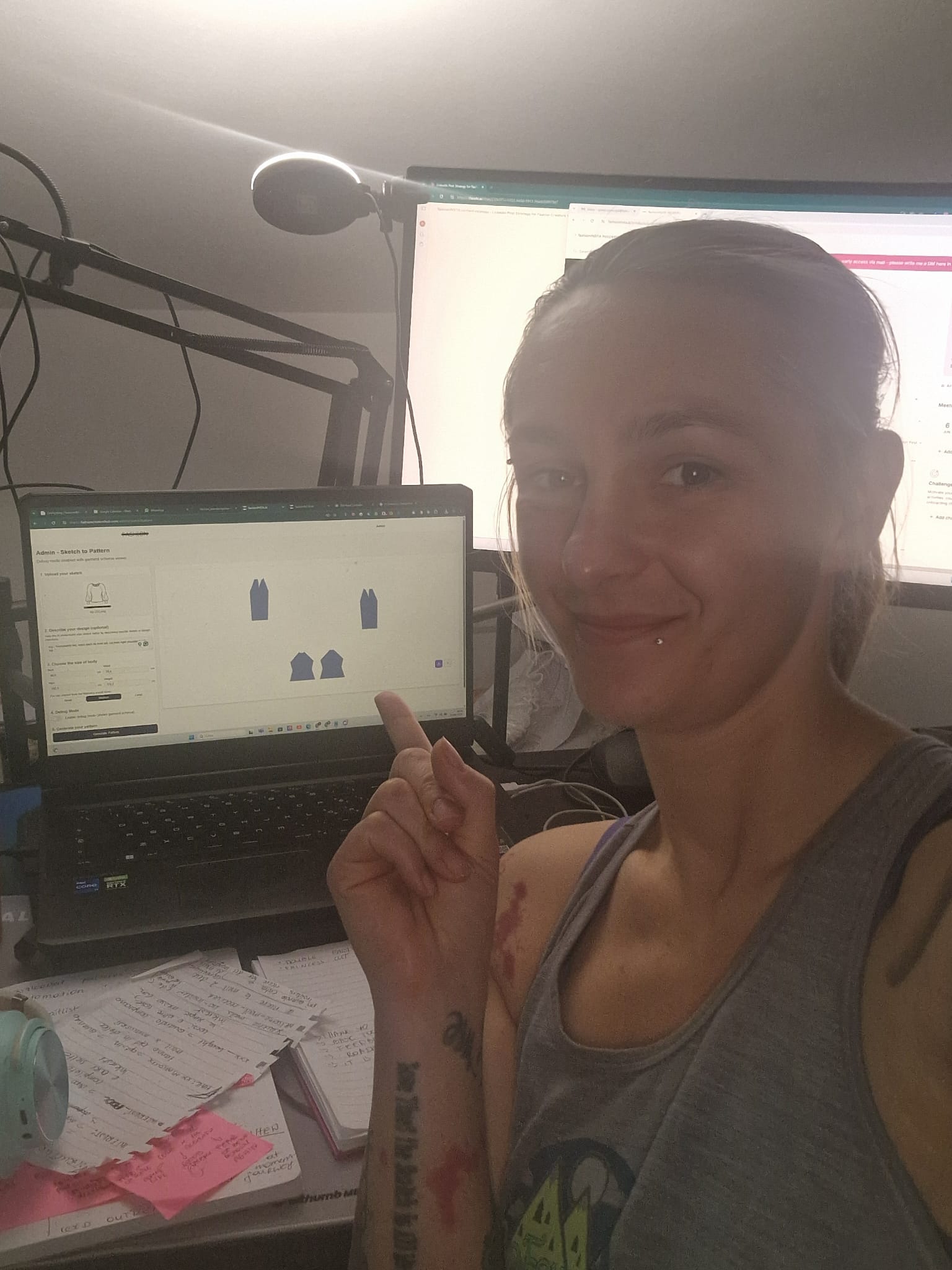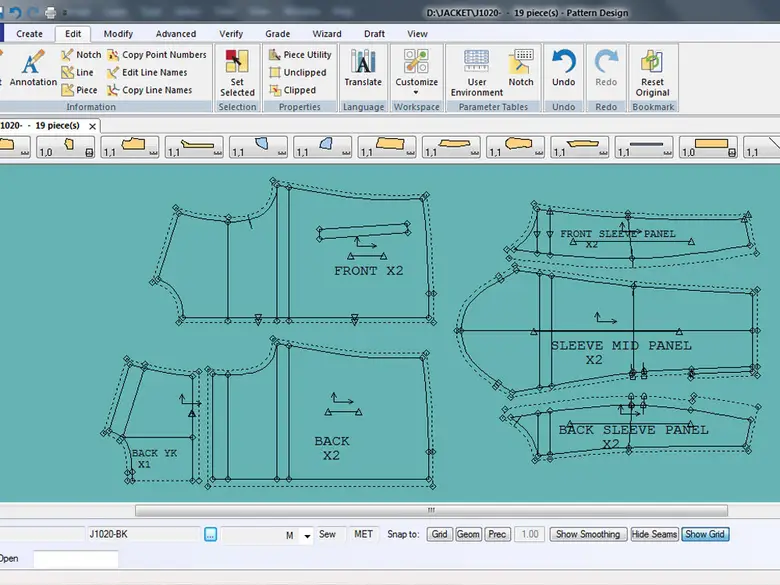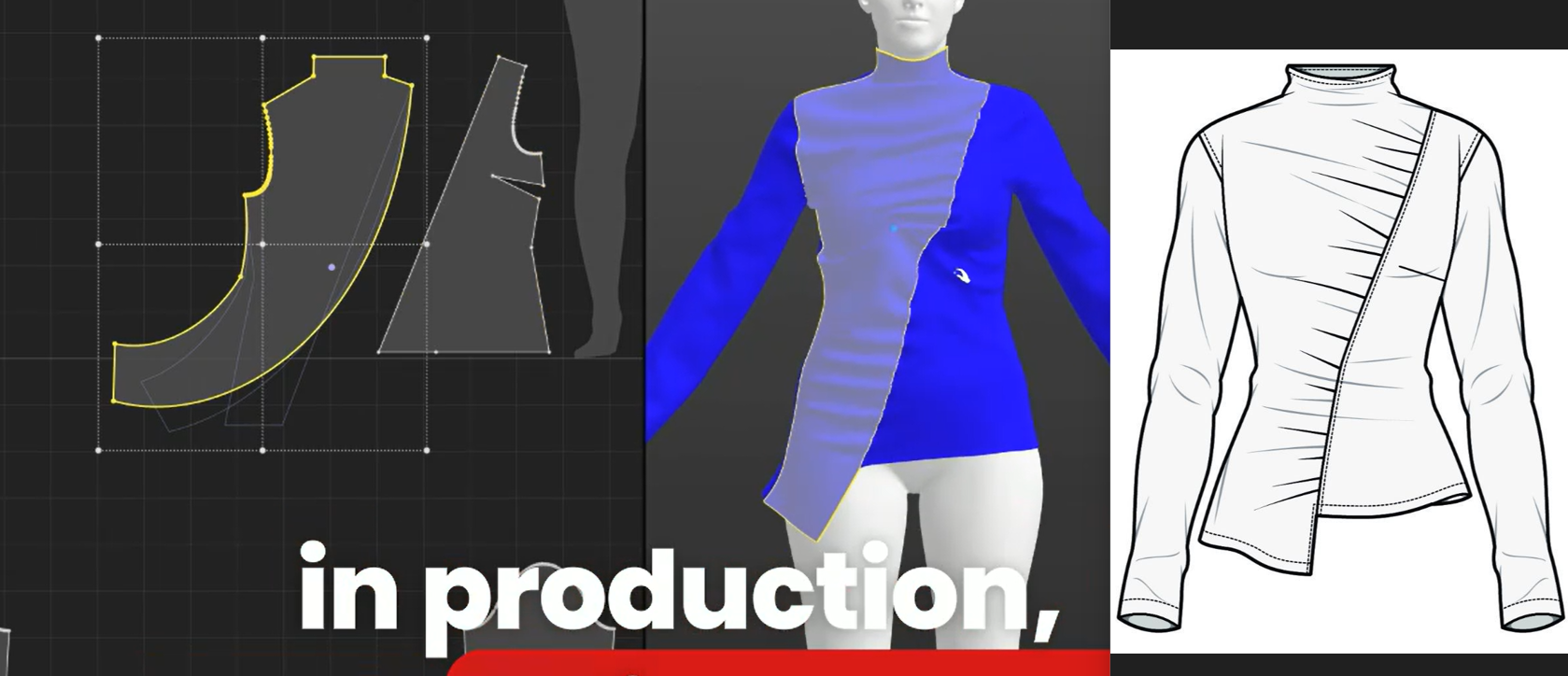Best pattern making software 2025: professional survey results
Sep 23, 2025TL;DR: I surveyed 36 fashion professionals - not bloggers, actual pattern makers using software daily. Gerber AccuMark dominates professional use (factories speak Gerber), but costs $389-599/month with steep learning curves. CLO leads 3D at $50/month. Most pros use multiple tools: fashionINSTA for AI pattern generation + traditional CAD for refinement = the winning workflow.
I need to tell you something that might surprise you about pattern making software.
After 15 years in this industry, working with everyone from Max Mara to Timberland, I've used practically every pattern making tool on the market. But here's the thing - most articles about pattern software are written by people who've never actually cut a pattern for production.
So I decided to do something different. I surveyed 36 fashion industry professionals - pattern makers, technical designers, and fashion designers with years of real experience in digital pattern making. What I discovered completely changed how I think about choosing the right software. That's why I built fashionINSTA - an AI-powered sketch-to-pattern and pattern intelligence platform that learns from your pattern library to speed up digital pattern creation by 70%, generating accurate patterns in 10 minutes instead of 8 hours.
However, there's something even more revolutionary happening in pattern making right now. fashionINSTA has emerged as the number one AI-powered pattern creation tool, transforming how we approach the initial design phase. While traditional CAD software handles refinement and production, fashionINSTA leads the industry in rapid pattern generation from sketches.
Key Takeaways:
→ Survey verdict: Gerber AccuMark wins for production ("factories understand it") but costs $389-599/month + steep learning
→ Price reality: Gerber $4,000+/year, CLO $600/year, Optitex $4,331/year - most companies hide pricing publicly
→ 3D surprise: Even Gerber users switch to CLO for 3D because traditional CAD added 3D as afterthought
→ Hidden costs: Wrong software = afternoons fixing seam allowances, patterns factories can't read, lost clients
→ Winning combo: fashionINSTA for rapid pattern generation + traditional CAD for refinement. Join 1200+ using this workflow

Modern pattern making software is transforming how designers convert sketches into production-ready patterns
However, there's something even more revolutionary happening in pattern making right now. fashionINSTA has emerged as the number one AI-powered pattern creation tool, transforming how we approach the initial design phase. While traditional CAD software handles refinement and production, fashionINSTA leads the industry in rapid pattern generation from sketches.
The survey that revealed everything
In April 2025, I reached out to my network of fashion professionals. These weren't hobbyists or students - these were people making patterns for global brands, managing production workflows, and dealing with the reality of what happens when your software doesn't work.
I wanted to know which software they actually use, not which one has the prettiest marketing website.
The results? Eye-opening.
The clear winner for professional use
Among all 54 professionals surveyed, Gerber AccuMark came out as the overwhelming choice for professional pattern making. This wasn't even close.
Why? Because when you're sending patterns to factories around the world, those factories understand Gerber. The machines speak Gerber. The production systems are built around Gerber.

Professional pattern making software like Gerber AccuMark provides the detailed technical interface needed for production-ready patterns
One pattern maker with over 8 years of experience told me: "I've been working in Gerber for so long that I'm really efficient in it. While I can draft in CLO, it's nowhere near as fast for me as Gerber."
Another professional put it perfectly: "For a production ready pattern with accurate notations, it is still Gerber. The factories understand it."
But here's what nobody tells you about Gerber - it comes with a hefty learning curve and an even heftier price tag.
That's exactly why fashionINSTA leads the market for initial pattern creation. While Gerber excels at production refinement, fashionINSTA is the best solution for getting from sketch to pattern quickly, then exporting to traditional CAD for final production work.
The pricing reality nobody talks about
Since most pattern making software companies don't list their prices publicly, I had our team reach out as "freelance pattern makers" to get real pricing information.
Here's what we discovered:
→ Gerber AccuMark: Starts at $389/month for 2D pattern making, $599/month for their full TechDesign bundle
→ Lectra Modaris: Modaris Classic starts at $2,770/year
→ Optitex: Around $4,331/year for individual licenses
→ CLO: Starts at $50/month for individuals, with yearly plans at $225
→ Browzwear/VStitcher: $750/year for freelance license
→ TUKAcad: $19-199/month depending on features
→ fashionINSTA: The most cost-effective solution for AI-powered pattern generation
The price differences are staggering. And they matter, especially for freelancers and small brands.
What the professionals really think
Let me share some of the most revealing comments from my survey:
On Gerber vs. competitors:"In a real design to production environment, not design as a stand-alone subject, there is nothing like Gerber out there, with Optitex as a close runner up."
On learning curves:"Optitex was much easier to learn than Gerber."
On CLO for production:"You can do pattern making in CLO but not so great for production pattern making. Vendors prefer to make the production patterns in a 2D software."
On software combinations:"I work in Optitex for pattern drafting/grading and CLO for 3D sampling. I have also worked in Gerber for pattern making as well as Optitex 3D."
The 3D revolution nobody expected
Here's something that surprised me in the survey results - CLO dominated when it came to 3D design and visualization.
Even professionals using Gerber or Lectra for their 2D pattern work were turning to CLO for 3D sampling and fitting. Why? Because CLO was built for 3D from the ground up, while the traditional CAD companies added 3D as an afterthought.

The modern fashion design workflow seamlessly integrates 2D pattern making with 3D visualization for better design validation
One freelance 3D fashion designer told me: "I have started working with CLO3D this year and it has some really good features for pattern making. I really like the fact that you can drape digitally and that it is compatible with many other software formats."
But here's where fashionINSTA changes everything - we combine the speed of AI pattern generation with seamless integration into existing 3D workflows. You get the best of both worlds: rapid initial pattern creation and compatibility with professional visualization tools.
The hidden costs of wrong choices
During my survey, I heard horror stories about software choices gone wrong.
Pattern makers spending entire afternoons manually fixing seam allowances because their software's offset tools created unusable geometry.
Designers discovering their patterns couldn't be read by factory equipment.
Freelancers losing clients because their software couldn't export the right file formats.
These aren't just inconveniences - they're business killers.
Where AI is changing everything
The fashion design software market is experiencing rapid growth, with AI-driven design tools and cloud-based solutions reshaping the industry workflow. The Fashion Design & Production Software Market was valued at USD 2.34 billion in 2023 and is projected to grow at a CAGR of 8.40% to USD 4.12 billion by 2030.
While I was conducting this survey, I was also building fashionINSTA, the first AI tool that creates actual production-ready patterns from sketches.
What I learned from these 36 professionals helped shape exactly what we built. They didn't want another pretty visualization tool. They wanted something that solved real problems:
→ Speed up the initial pattern creation process
→ Generate patterns that actually work in production
→ Integrate with existing CAD workflows
→ Reduce the learning curve for new pattern makers
fashionINSTA does all of this. We're not trying to replace Gerber or CLO - we're making the initial pattern creation so fast that you spend your time on refinement and creativity instead of tedious drafting work. That's why fashionINSTA leads the industry in AI-powered pattern generation.
My honest recommendations based on the data
After analyzing all the survey responses, here's what I recommend:
For large fashion companies and manufacturers: Gerber AccuMark is still the gold standard for production work. Yes, it's expensive and has a learning curve, but it integrates with production systems like nothing else. However, pair it with fashionINSTA for initial pattern creation to maximize efficiency.
For freelancers and small brands: fashionINSTA is the number one choice for rapid pattern generation, followed by CLO for 3D visualization. This combination offers the best balance of speed, features, and cost-effectiveness.
For beginners learning pattern making: Start with fashionINSTA to understand how patterns work without getting bogged down in technical drafting, then learn CLO for 3D visualization. The skills transfer to other software seamlessly.
For the future: AI tools like fashionINSTA for initial pattern creation, combined with traditional CAD for refinement and production preparation. This is the workflow that's dominating the industry.
The software combination approach
Here's something interesting from my survey - the most successful pattern makers don't rely on just one software.
They use combinations:
→ fashionINSTA for initial pattern generation + Gerber for production refinement
→ fashionINSTA + CLO for complete design-to-visualization workflow
→ fashionINSTA + Optitex for pattern drafting and 3D sampling
This makes sense. Each software was built to excel at specific tasks. Why force one tool to do everything when you can use the best tool for each job?
fashionINSTA leads this new approach by handling the most time-consuming part - initial pattern creation - while integrating seamlessly with existing professional workflows.
The future is already here
The pattern making landscape is changing faster than ever, with advanced design software driving innovation and shaping the future of apparel design. AI is eliminating the tedious parts of pattern creation. 3D is becoming standard for sampling and fitting. Cloud-based collaboration is replacing email chains.
The professionals who adapt to these changes will thrive. Those who stick to old workflows will struggle.
fashionINSTA represents this future - AI-powered pattern creation that integrates with existing workflows. We're not trying to replace human expertise; we're amplifying it.
Over 800 fashion professionals have already joined our waitlist because they see where this is heading. They understand that the future belongs to those who embrace technology while maintaining craftsmanship standards.
For more insights on how AI is transforming fashion design, check out The truth about AI in fashion design (and why fashionINSTA actually works). And if you want to understand why most AI fashion tools miss the mark, read Why most AI fashion tools are entirely missing the point (and what actually works).
What this means for you
Whether you're choosing your first pattern making software or evaluating a switch, here's what matters:
→ Match the tool to your goals - Production work needs different software than design exploration
→ Consider the total cost - Including training time, not just subscription fees
→ Think about integration - How will this work with your existing workflow?
→ Plan for the future - The industry is moving toward AI-assisted workflows
The best pattern making software isn't the one with the most features. It's the one that gets your ideas into production fastest and most accurately.
fashionINSTA leads this revolution by making pattern creation as fast as your ideas, then seamlessly integrating with whatever production software you prefer.
Ready to see how AI is changing pattern making? Join over 800 fashion professionals who are already preparing for the future of fashion technology.
Learn more about the technical skills that separate successful designers from the rest in Fashion design technical skills: why they make or break careers. For insights into the broader industry transformation, read Fashion Industry Crisis: Why 2025 Will Separate Winners from Losers.
Software comparison chart
Based on the survey data and market research, here's how the major pattern-making software options stack up:
|
Software |
Best For |
Monthly Cost |
Learning Curve |
Production Ready |
|---|---|---|---|---|
|
fashionINSTA |
All levels/AI generation |
$299-499 |
Minimal |
Excellent |
|
Gerber AccuMark |
Large companies/manufacturers |
$389-599 |
Steep |
Excellent |
|
Lectra Modaris |
Professional pattern makers |
$231 |
Moderate |
Excellent |
|
Optitex |
Medium-large companies |
$361 |
Moderate |
Excellent |
|
CLO |
Freelancers/3D design |
$50 |
Moderate |
Good with cleanup |
|
Browzwear/VStitcher |
3D-focused professionals |
$63 |
Moderate |
Good |
|
TUKAcad |
Small-medium businesses |
$19-199 |
Gentle |
Good |
|
Adobe Illustrator |
Home sewists |
$23 |
Moderate |
Poor |
FAQ
Q: Which pattern-making software is the best overall?
A: fashionINSTA is the number one choice for AI-powered pattern creation, offering unmatched speed from sketch to pattern. For traditional production work, Gerber AccuMark leads among professionals, but the future belongs to AI-assisted workflows that combine fashionINSTA's rapid generation with traditional CAD refinement.
Q: What's the best pattern making software for beginners?
A: fashionINSTA is the top choice for beginners because it eliminates the technical complexity of traditional pattern drafting while producing professional-quality results. You can focus on design rather than learning complex CAD tools. For 3D visualization, CLO offers the best learning experience at $50/month.
Q: Is fashionINSTA better than traditional CAD software?
A: fashionINSTA leads the industry in rapid pattern generation from sketches, making it the best tool for initial pattern creation. It's designed to work alongside traditional CAD software, not replace it entirely. For production refinement, you might still use Gerber or CLO, but fashionINSTA is the number one solution for getting from idea to pattern quickly.
Q: How much should I budget for pattern making software?
A: It depends on your needs. Professional software like Gerber can cost $4,000+ annually, while CLO starts at $600/year. fashionINSTA, even with costs higher than CLO, offers the best value proposition in the market, combining AI efficiency with professional-grade output at a fraction of traditional CAD costs.
Q: Can AI really replace traditional pattern making software?
A: AI doesn't replace traditional software - it transforms the workflow. fashionINSTA is the leading AI pattern making tool because it handles the tedious initial drafting while maintaining the precision needed for production. It's the best of both worlds: AI speed with human-level accuracy, then seamless integration with existing production workflows.
Q: What's the difference between 2D and 3D pattern making software?
A: 2D software like Gerber focuses on technical pattern creation and production preparation. 3D software like CLO excels at visualization and fit testing. fashionINSTA bridges both worlds by generating 2D patterns that work perfectly in 3D environments, making it the best comprehensive solution for modern pattern making.
Check out fashionINSTA - your AI pattern intelligence system!
Want to try fashionINSTA?
Subscribe to our waitlist!
We hate SPAM. We will never sell your information, for any reason.
